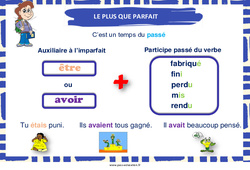

How do you form the pluperfect in English?Īs you will have noticed in my example just above, the pluperfect is formed with the auxiliary had and the past participle of the verb ( started in our example). We had already started eating when he arrived. Let me give you an example to illustrate what I’m saying. It basically entitles you to express an action in the past that has been completed before another action in the past. As you would have understood, it is a tense that belongs to the past.

It can either be called the pluperfect, the past perfect, the past perfective or even the past in the past.

It has different names (it adds a bit of spice, don’t you think?). Here’s a quick reminder of what this tense is in … English! If unfortunately, that is not the case, I will recommend you some very interesting and easy to understand websites to learn the plus que parfait tense in French. On a more serious note, I think that after my little lesson on the plus que parfait, all your questions will be answered to. Not a problem, you have come to the right page as I will refresh your memory thanks to a quick brush-up on the notion. Luckily though, the French and the English pluperfect are rather similar.Īre you not too sure of what the plus que parfait exactly is nor when this tense should be used? I personally find the French conjugation slightly (quite a lot, let’s face it) more difficult than the English one. In that case, you will soon start to learn about the pluperfect, le plus que parfait in French. Are you an intermediate to advanced learner?


 0 kommentar(er)
0 kommentar(er)
